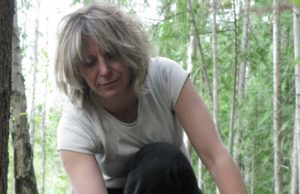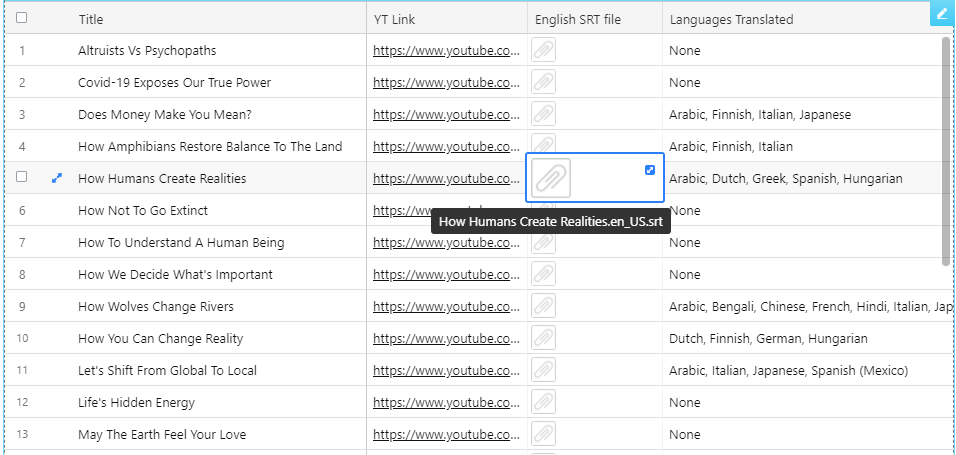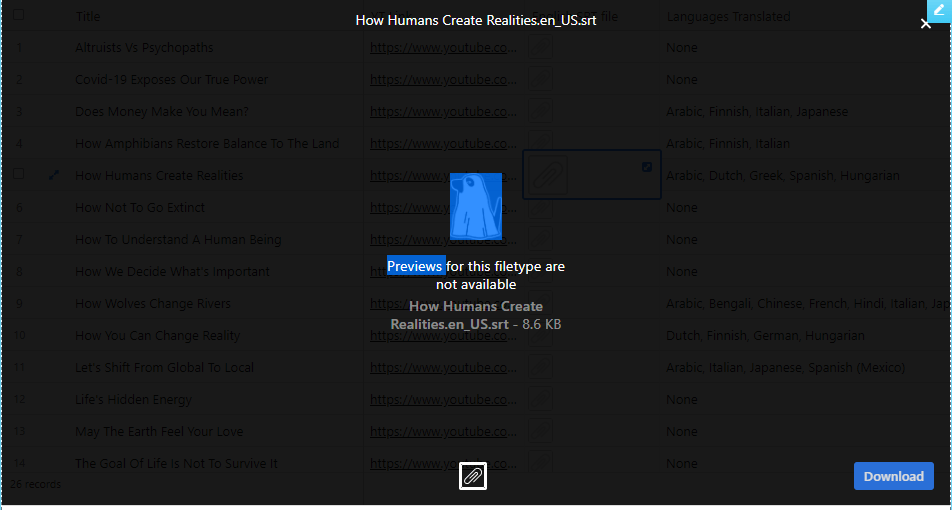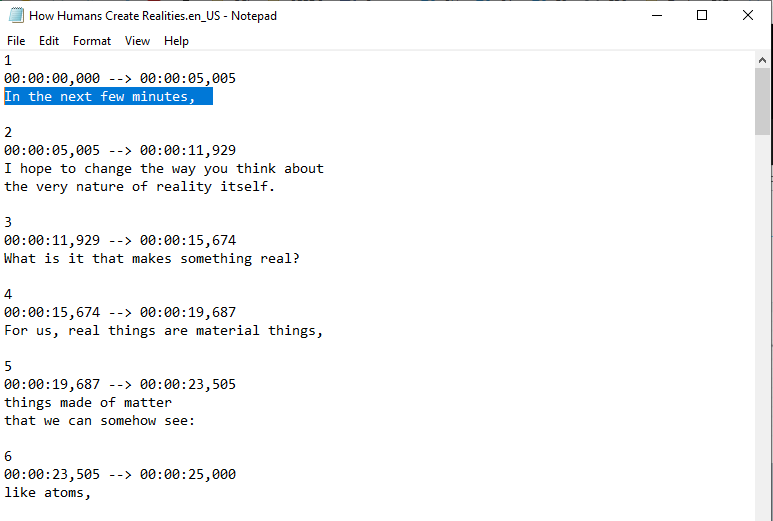In the enlightening video “How Trees Talk,” Dr. Suzanne Simard takes viewers on a journey into the hidden, interconnected world beneath a forest’s surface. This fascinating exploration reveals the complex and sophisticated network of mycorrhizal fungi, known as the “wood wide web,” which connects trees in a dense, interdependent web of life. Dr. Simard explains how this underground network facilitates communication and resource sharing among trees, transcending species boundaries and functioning as a unified organism.
The concept of “mother trees” is introduced, highlighting how these pivotal trees nurture younger ones, sharing nutrients and vital survival information through the mycorrhizal network. This intricate system allows for the transfer of carbon, defense signals, and wisdom from older, dying trees to the next generation, ensuring the forest’s resilience and continuity. The video delves into groundbreaking research that uses isotope tracing to visualize the flow of resources and signals through this network, emphasizing the communal and cooperative nature of forest ecosystems.
However, Dr. Simard also addresses the vulnerability of forests to human activities like clear-cut logging, which can disrupt these essential networks and lead to widespread ecological consequences. She warns of the tipping point where removing too many key trees – the “hub trees” – can lead to catastrophic collapse of the entire system. Such destruction affects not only the trees but also the broader environment, impacting water cycles, wildlife habitats, and contributing to climate change.
The video concludes with a powerful message advocating for the preservation of old-growth forests, the guardians of genetic diversity and mycorrhizal networks. Dr. Simard calls for sustainable forestry practices that protect mother trees and their networks, allowing them to impart their wisdom to future generations. She emphasizes the need for diverse, multi-species replanting and natural regeneration to restore and maintain the health and resilience of forest ecosystems. Ultimately, “How Trees Talk” is a call to action to recognize and preserve the remarkable, cooperative intelligence of forests, fundamentally challenging the way we view and interact with these vital ecosystems.
Imagine you’re walking through a forest. I’m guessing you’re thinking of a collection of trees but a forest is much more than what you see. Underground there is this other world, a world of infinite biological pathways that connect trees and allow them to communicate and allow the forest to behave as though it’s a single organism.
Mycorrhiza literally means “fungus root.” They’re the mushrooms. The mushrooms are fungal threads that form a mycelium and where the fungal cells interact with the root cells, there’s a trade of carbon for nutrients. The web is so dense that there can be hundreds of kilometers of mycelium under a single footstep. That mycelium connects different individuals in the forest, individuals not only of the same species but between species.
We have found that mother trees nurture their young. A mother tree can be connected to hundreds of other trees. We have found that mother trees will send their excess carbon through the mycorrhizal network to the understory seedlings. They even reduce their own root competition to make elbow room for their kids. When mother trees are injured or dying, they also send messages of wisdom on to the next generation of seedlings. We’ve used isotope tracing to trace carbon moving from an injured mother tree down her trunk into the mycorrhizal network and into her neighboring seedlings, not only carbon but also defense signals. Through back and forth conversations, they increase the resilience of the whole community. That’s because there are many hub trees and many overlapping networks. So trees talk.
But they’re also vulnerable, vulnerable not only to natural disturbances like bark beetles that preferentially attack big old trees but high-grade logging and clear-cut logging. You see, you can take out one or two hub trees, but there comes a tipping point, because hub trees are not unlike rivets in an airplane. You can take out one or two and the plane still flies, but you take out one too many, or maybe that one holding on the wings,and the whole system collapses. Massive disturbance at this scale is known to affect hydrological cycles, degrade wildlife habitat, and emit greenhouse gases back into the atmosphere, which creates more disturbance and more tree diebacks.
We need to save our old-growth forests. These are the repositories of genes and mother trees and mycorrhizal networks. We need to reestablish local involvement in our own forests. When we do cut, we need to save the mother trees and networks so they can pass their wisdom onto the next generation of trees so they can withstand the future stresses coming down the road. We need to regenerate our forests with a diversity of species and genotypes and structures by planting and allowing natural regeneration. We have to give Mother Nature the tools she needs to use her intelligence to self-heal. And we need to remember that forests aren’t competing with each other, they’re supercooperators.
 Suzanne Simard is a Canadian scientist who is a professor in the Department of Forest and Conservation Sciences at the University of British Columbia. She received her PhD in Forest Sciences at Oregon State University. Before beginning to teach at the University of British Columbia, Simard worked as a research scientist at the British Columbia Ministry of Forests. Simard is best known for the research she has conducted on the underground networks of forests characterized by fungi and roots. She studies how these fungi and roots facilitate communication and interaction between trees and plants of an ecosystem.
Suzanne Simard is a Canadian scientist who is a professor in the Department of Forest and Conservation Sciences at the University of British Columbia. She received her PhD in Forest Sciences at Oregon State University. Before beginning to teach at the University of British Columbia, Simard worked as a research scientist at the British Columbia Ministry of Forests. Simard is best known for the research she has conducted on the underground networks of forests characterized by fungi and roots. She studies how these fungi and roots facilitate communication and interaction between trees and plants of an ecosystem.
“Every organisms in the forest has its own rule to balance the ecosystem or the energy flow.”
“Beautiful…I can always feel their energy…I always hug my trees and talk to them.”
“I have always had a passion for trees, and forests are where I find most peace. Being a gardener, I have known about this world under our feet and, as stewards of this one earth that we share with nature, we should all take time to be curious and inform ourselves on how to do it properly.”
“Somehow I’ve known this for most of my life. It is good to see it scientifically recognized.”
“If everyone could watch this video, another world we could have!”
“Amazing video footage with fascinating information.”
“Absolutely love this awesome video. What an amazingly magical boarding school Mother Earth provides us with.”
Music:
“Another Version Of You” – Chris Zabriskie
Science:
- Simard, S.W. (2021). Finding the Mother Tree. Penguin Random House.
- Birch, J.D., Simard, S.W., Beiler, K., and Karst, J. (2021). Beyond seedlings: ectomycorrhizal networks and growth of mature Pseudotsuga menziesii. Journal of Ecology 109: 806-818.
- Simard, S.W. (2021). The mother tree. In: Tree Story, Monash University Museum of Art, Melbourne, Australia.
- Simard, S.W., Roach, W.J., Beauregard, J., Burkart, J., Cook, D., Law, D., Schacter, T., Murphy-Steed, A., Zickmantel, A., Armstrong, G., Fraser, K.M., Hart, L., Heath, O.R.J., Jones, L., Sachs, N.S., Sachs, H.R., Snyder, E.N., Tien, M., and Timmermans, J. (2021). Partial retention of legacy trees protect mycorrhizal inoculum potential, biodiversity and soil resources while promoting natural regeneration of interior Douglas-fir. Frontiers in Forests and Global Change.
- Asay, A.K., Simard, S.W., and Dudley, S.A. (2020). Altering neighborhood relatedness and species composition affects interior Douglas-fir size and morphological traits with context- dependent responses. Frontiers in Ecology and Evolution 8: 314.
- Ibarra, J.T. Cockle, K., Altamirano, T., Van der Hoek, Y., Simard, S.W., Bonacic, C., and Martin, K. (2020). Nurturing resilient forest biodiversity: nest webs as complex adaptive systems. Ecology and Society 25(2):27.
- Modi, D., Simard, S.W., Bérubé, J., Lavkulich, L., Hamelin, R., and Grayston, S.J. (2020). Long-term effects of stump removal and tree species composition on the diversity and structure of soil fungal communities. FEMS Microbiology Ecology 96(5): fiaa061.
- Modi, D., Simard, S.W., Lavkulich, L.M., Hamelin, R., and Grayston, S.J. (2020). Stump removal and tree species composition promote a bacterial microbiome that appears beneficial in the suppression of root disease. FEMS Microbiology Ecology fiaa213.
- Simard, S.W., Roach W.J., Defrenne, C.E., Pickles, B.J., Snyder, E.N., Robinson, A., and Lavkulich, L.M. (2020). Harvest Intensity Effects on Carbon Stocks and Biodiversity Are Dependent on Regional Climate in Douglas-Fir Forests of British Columbia. Frontiers in Forests and Global Change, 3(88).
- Van Dorp, C., Simard, S.W., and Durall, D.M (2020). Resilience of Rhizopogon-Douglas-fir mycorrhizal networks 25 years after selective logging. Mycorrhiza 30: 467–474
- Defrenne CE, McCormack LM, Roach WJ, Addo-Danso SD, and Simard SW (2019). Intraspecific fine-root trait-environment relationships across interior Douglas-Fir forests of western Canada. Plants, 8: 199.
- Defrenne, C.E., Philpott, T.J., Guichon, S.H.A., Roach, W.J., Pickles, B.J. and Simard, S.W. (2019). Shifts in Ectomycorrhizal Fungal Communities and Exploration Types Relate to the Environment and Fine-Root Traits Across Interior Douglas-Fir Forests of Western Canada. Frontiers in Plant Science.
- Simard, S.W. (2018). Mycorrhizal networks facilitate tree communication, learning and memory. In: Baluska, F., Gagliano, M., and Witzany, G. (eds.), Memory and Learning in Plants. Springer, ISBN 978-3-319-75596-0. Chapter 10, pp. 191-213.
- Maddison, J.A., Kržic, M.́, Simard, S.W., Adderly, C., and Khan, S. (2018). Shroomroot – an action-based digital game to enhance postsecondary teaching and learning about mycorrhizae. American Biology Teacher, 80(1): 11-20. DOI: 10.1525/abt.2018.80.1.11
- Snyder, E., Simard, S.W. (2018). It starts with soil: how to increase the resilience of urban forests. Sitelines, October, 8-9.
- Pither J, Pickles BJ, Simard SW, Ordonez A, Williams JW (2018). Belowground biotic interactions moderated the post-glacial range dynamics of trees. New Phytolgoist, 220: 1148-1160.
- Pickles, D.R.B., and Simard, S.W. (2017). Mycorrhizal networks and forest resilience to drought. Elsevier In: Johnson, N. C., Gehring, C. and Jansa, J. (eds.) Mycorrhizal Mediation of Soil – Fertility, Structure, and Carbon Storage. Elsevier, Amsterdam, pp. 319-339. ISBN 9780128043127.
- Simard, S.W. (2017). The mother tree. K. Verlag and the Haus der Kulturen der Welt, Berlin Edited by Anna-Sophie Springer & Etienne Turpin. The Word for World is Still Forest. ISBN 978-3-9818635-0-5
- Defrenne, C.A., Oka, G.A., Wilson, J.E., Simard, S.W. and Lavkulich, L.M. (2016). Disturbance legacy on soil carbon stocks and stability within a coastal temperate forest of southwestern British Columbia, Canada. Scientific Research Publishing Open Journal of Forestry, 6: 305-323.
- Deslippe , J.R., Hartmann, M., Grayston, S.J., Simard, S.W., and Mohn, W.W. (2016). Stable isotope probing implicates Cortinarius collinitus in carbon transfer through ectomycorrhizal mycelial networks in the field. New Phytologist, 210: 383-390
- Simard, S.W. (2016). Unseen connections. Marc Guttman We Discover, www.wediscover.net.
- Pickles BJ, Wilhelm R, Asay AK, Hahn A, Simard SW, and Mohn WW (2016). Transfer of 13C between paired Douglas-fir seedlings reveals plant kinship effects and uptake of exudates by ectomycorrhizas. New Phytologist, 214: 400-411.
- Chaudhary VB, Rúa MA, Antoninka A, Bever JD, Cannon J, Craig A, Duchicela J, Frame A, Gardes M, Gehring C, Ha M, Hart M, Hopkins J, Ji B, Johnson NC, Kaonongbua W, Karst J, Koide R, Lamit LJ, Meadow J, Milligan BG, Moore JC, Pendergast IV TH, Piculell B, Ramsby B, Simard SW, Shrestha S, Umbanhowar J, Viechtbauer W. Lawrence Walters, Gail Wilson, Peter C. Zee, and Jason Hoeksema. (2016). MycoDB: A global database of plant response to mycorrhizal fungi. Nature / Scientific Data, 3: 160028.
- Pickles, B.J., Twieg, B.D., O’Neill, G.A., Mohn, W.W, and Simard, S.W. (2015). Local adaptation in migrated interior Douglas-fir seedlings is mediated by ectomycorrhizae and other soil factors. New Phytologist, 207: 858–871.
- Karst, J., Erbilgin, N., Pec, G.J., Cigan, P.W,, Najar, A., Simard, S.W,, Cahill Jr., J.F. (2015). Ectomycorrhizal fungi mediate indirect effects of a bark beetle outbreak on secondary chemistry and establishment of pine seedlings. New Phytologist, 208: 904–914.
- Baleshta, K.E., Simard, S.W., and Roach, W.J. (2015). Effects of thinning paper birch on conifer productivity and understory plant diversity. Scandanavian Journal of Forest Research, 30: 699-709.
- Song, Y.Y. Simard, S.W., Carroll, A., Mohn, W.W. and Zheng, R.S. (2015). Defoliation of interior Douglas-fir elicits carbon transfer and defense signalling to ponderosa pine neighbors through ectomycorrhizal networks. Nature / Sci. Rep. 5, 8495; DOI:10.1038/srep08495 (2015).
- Potvin C., Aitken S., Simard S.W., and 62 other Canadian Scholars (2015). Acting on climate change: solutions from Canadian scholars. UNESCO Chair for dialogues on Sustainability, Trottier Institute for Science and Public Policy, and Sustainable Canada Dialogues.
- Simard, S.W. (2015). Conversations in the forest: The roots of natures equanimity. SGI Quarterly, 79: 8-9.
- Gorzelak, M., Pickles, B.J., Asay, A.K., Simard, S.W. (2015). Inter-plant communication through mycorrhizal networks mediates complex adaptive behaviour in plant communities. Annals of Botany Plants 7: plv050.
- Beiler, K.J., Simard, S.W. and Durall, D.M. (2015). Topology of Rhizopogon spp. mycorrhizal meta-networks in xeric and mesic old-growth interior Douglas-fir forests. Journal of Ecology, 103(3): 616-628.
- Simard, S.W., Asay, A.K., Beiler, K.J., Bingham, M.A., Deslippe, J.R., He, X., Philip, L.J., Song, Y., Teste, F.P. (2015). Resource transfer between plants through ectomycorrhizal networks. In: Mycorrhizal Networks. Edited by T. R. Horton. Springer, Netherlands. Ecological Studies 224, pp. 133-176. ISBN 978-94-017-7394-2.
- Barker, J.S., Simard, S.W., and Jones, M.D. (2014). Clearcutting and wildfire have comparable effects on growth of directly seeded interior Douglas-fir. Forest Ecology & Management, 331: 188-195.
- Treu, R., Karst, J., Randall, M., Pec, G.J., Cigan, P., Simard, S.W., Cooke, J., Erbilgin, N., and Cahill Jr., J.F. (2014). Decline of ectomycorrhizal fungi following mountain pine beetle infestation. Ecology, 95:1096–1103. http://dx.doi.org/10.1890/13-1233.1
- Filotas, E., Parrott, L., Burton, P.J., Chazdon, R.L., Coates, K.D., Coll, L., Haeussler, S., Martin, K., Nocentini, S., Puettmann, K.J., Putz, F.E., Simard, S.W., and Messier, C. (2014). Viewing forests through the lens of complex systems science. Ecosphere 5:art1
- Barker, J.S., Simard, S.W., Jones, M.D., and Durall, D.M. (2013). Ectomycorrhizal fungal community assembly on regenerating Douglas-fir after wildfire and clearcut harvesting. Oecologia, 172: 1179-1189.
- Bingham, M.A., and Simard, S.W. (2013). Seedling genetics and life history outweigh mycorrhizal network potential to improve conifer regeneration under drought. Forest Ecology & Management, 287: 132-139.
- Pollan, Michael (2013). The intelligent plant: scientists debate a new way of understanding flora. The New Yorker, December 23, 2013
- Simard, S.W. (2013). Practicing mindful silviculture in our changing climate. Silviculture Magazine, Fall 2013: 6-8
- Simard, S.W., Martin, K., Vyse, A., and Larson, B. (2013). Meta-networks of fungi, fauna and flora as agents of complex adaptive systems. Chapter 7, pages 133-164. In: Managing World Forests as Complex Adaptive Systems: Building Resilience to the Challenge of Global Change. Edited by Puettmann, K, Messier, C, and Coates, KD. Routledge, NY. ISBN 978-0-415-51977. 369pp.
- Simard, S.W. (2012). Mycorrhizal networks and seedling establishment in Douglas-fir forests. Biocomplexity of Plant–Fungal Interactions, First Edition. Edited by Darlene Southworth. John Wiley & Sons, Inc. Chapter 4, pages 85-107. ISBN-10: 0813815940 | ISBN-13: 978-0813815947 |
- Simard, S.W., and Martin, K. (2012). The powerful networks of forests. Friends of Clayquot Sound Newsletter, Summer: 6.
- Bingham, M.A., and Simard, S.W. (2012). Mycorrhizal networks affect ectomycorrhizal fungal community similarity between conspecific trees and seedlings. Mycorrhiza, 22: 317–326.
- Bingham, M.A., and Simard, S.W. (2012). Ectomycorrhizal networks of old Pseudotsuga menziesii var. glauca trees facilitate establishment of conspecific seedlings under drought. Ecosystems, 15: 188-199.
- Simard, S.W., Beiler, K.J., Bingham, M.A., Deslippe. J.R., Philip, L.J., and Teste, F.P. (2012). Mycorrhizal networks: mechanisms, ecology and modelling. Invited Review. Fungal Biology Reviews, 26: 39-60.
- Beiler, K.J., Simard, S.W., Lemay, V., and Durall, D.M. (2012). Vertical partitioning between sister species of Rhizopogon fungi on mesic and xeric sites in an interior Douglas-fir forest. Molecular Ecology, 21: 6163-6174.
- Deslippe, J.R., and Simard, S.W. (2011). Below-ground carbon transfer among Betula nana may increase with warming in Arctic tundra. New Phytologist, 192(3): 689-698.
- Bingham, M.A., and Simard, S.W. (2011). Do mycorrhizal network benefits to survival and growth of interior Douglas-fir seedlings increase with soil moisture stress? Ecology and Evolution, 3(1): 306-316.
- Philip LJ, Simard SW, Jones MD (2011). Pathways for belowground carbon transfer between paper birch and Douglas-fir seedlings. Plant Ecology & Diversity, 3: 221-233.
- Deslippe, J.R., Hartmann, M., Mohn, W.W. and Simard, S.W. (2011). Long-term experimental manipulation of climate alters the ectomycorrhizal community of Betula nana in Arctic tundra. Global Change Biology, 17: 1625–1636.
- Simard, S.W. and Austin, M.E. (2010). The role of mycorrhizas in forest soil stability with climate change. Sciyo, Chapter 15, pp 275-302. Climate Change and Variability, Suzanne Simard (Ed.), ISBN: 978-953-307-144-2
- Teste FP, Simard SW, Durall DM, Guy R, Berch SM (2010). Net carbon transfer occurs under soil disturbance between Pseudotsuga menziesii var. glauca seedlings in the field. Journal of Ecology, 98: 429-439
- Jones MD, Twieg B, Ward V, Barker J, Durall DM, Simard SW (2010). Functional complementarity of Douglas-fir ectomycorrhizas for extracellularenzyme activity after wildfire or clearcut logging. Functional Ecology, 4: 1139-1151.
- Beiler KJ, Durall DM, Simard SW, Maxwell SA, Kretzer AM (2010). Mapping the wood-wide web: mycorrhizal networks link multiple Douglas-fir cohorts. New Phytologist, 185: 543-553.
- Teste FP, Simard SW, Durall DM (2009). Role of mycorrhizal networks and tree proximity in ectomycorrhizal colonization of planted seedlings. Fungal Ecology, 2(1): 21-30.
- Twieg B, Durall DM, Simard SW, and Jones MD. (2009). Influence of soil nutrients on ectomycorrhizal communities in a chronosequence of mixed temperate forests. Mycorrhiza, 19(5): 305-316.
- Teste FP, Simard SW, Durall DM, Guy RD, Jones MD, Schoonmaker AL (2009). Access to mycorrhizal networks and tree roots: importance for seedling survival & resource transfer. Ecology, 90: 2808-2822
- Kazantseva O, Bingham MA, Simard SW, Berch SM (2009). Effects of growth medium, nutrients, water and aeration on mycorrhization and biomass allocation of greenhouse-grown interior Douglas-fir seedlings. Mycorrhiza, 20: 51-66.
- Simard SW (2009). Mycorrhizal networks and complex systems: contributions of soil ecology science to managing climate change effects in forested ecosystems. Canadian Journal of Soil Science, 89(4): 369-382.
- Simard, SW (2009). The foundational role of mycorrhizal networks in self-organization of interior Douglas-fir forests. Forest Ecology and Management, 258S: S95–S107.
- Simard SW. (2009). Response diversity of mycorrhizas in forest succession following disturbance. In: C. Azcon-Aguilar, J.M. Barea, S. Gianinazzi, and V. Gianinazzi-Pearson. Mycorrhizas: functional processes and ecological impacts. Springer-Verlag, Heidelberg. ISBN 978-3-540-87977-0. Chapter 13, pp. 187-206.
- Teste FP, and Simard SW. (2008). Mycorrhizal networks and distance from mature trees alter patterns of competition and facilitation in dry Douglas-fir forests. Oecologia, 158: 193-203.
- Philip LJ, and Simard SW. (2008). Minimum pulses of stable and radioactive carbon isotopes to detect belowground carbon transfer between plants. Plant and Soil, 308: 23-35.
- Schoonmaker, A.L., Teste, F.P., Simard, S.W., Guy, R.D. (2007). Tree proximity, soil pathways and common mycorrhizal networks: their influence on utilization of redistributed water by understory seedlings. Oecologia, 154:455-466
- Twieg, B.D., Durall, D.M., Simard, S.W. (2007). Ectomycorrhizal fungal succession in mixed temperate forests. New Phytologist, 176: 437-447.
- Durall, D.M., Gamiet, S., Simard, S.W., Kudrna, L., and Sakakibara, S.M. (2006). Effects of clearcut logging and tree species composition on the diversity and community composition of epigeous fruit bodies formed by ectomycorrhizal fungi. Canadian Journal of Botany, 84: 966-980.
- Sellosse, M.-A., Richard, F., He, X., and Simard, S.W. (2006). Mycorrhizal networks: les liaisons dangeureuses? Trends in Ecology and Evolution, 21: 621-628.
- Johnson NC, Hoeksema J, Abbott L, Bever J, Chaudhary VB, Gehring C, Klironomos J, Koide R, Miller RM, Moore J, Moutoglis P, Schwartz M, Simard SW, Swenson W, Umbanhowar J, Wilson G, and Zabinski C. (2006). From Lilliput to Brobdingnag: extending models of mycorrhizal function across scales. Bioscience, 56(11): 889-900.
- Simard, S.W., Durall, D.M. (2004). Mycorrhizal networks: a review of their extent, function and importance. Canadian Journal of Botany, 82(8): 1140-1165.
- DeLong, R., Lewis, K.J., Simard, S.W., Gibson, S. (2002). Fluorescent pseudomonad population sizes baited from soils under pure birch, pure Douglas-fir and mixed forest stands and their antagonism toward Armillaria ostoyae in vitro. Canadian Journal of Forest Research, 32: 2146-2159.
- Sakakibara, S.M., Jones, M.D., Gillespie, M., Hagerman, S.H., Forrest, M.E., Simard, S.W., Durall, D.M. (2002). A comparison of ectomycorrhiza identification based on morphotyping and PCR-RFLP analysis. Mycological Research, 106: 868-878.
- Simard, S.W., Jones, M.D., and Durall, D.M. (2002). Carbon and nutrient fluxes within and between mycorrhizal plants. Springer In: M. van der Heijden and I. Sanders. Mycorrhizal Ecology. Springer-Verlag, Heidelberg. Ecological Studies, Vol. 157: 33-61.
- Wiensczyk, A., Gamiet, S., Durall, D., Jones, M., and Simard, S.W. (2002). Ectomycorrhizae and forestry in British Columbia: A summary of current research and conservation strategies. British Columbia Journal of Ecosystems and Management, 2(1): 1-19.
- Simard, S.W., Perry, D.A., Jones, M.D., Myrold, D.D., Durall, D.M., and Molina, R. (1997). Net transfer of carbon between tree species with shared ectomycorrhizal fungi. Nature, 388: 579-582.
- Simard, S.W., Molina, R., Smith, J.E., Perry, D.A., and Jones, M.D. (1997). Shared compatibility of ectomycorrhizae on Pseudotsuga menziesii and Betula papyrifera seedlings grown in mixture in soils from southern British Columbia. Canadian Journal of Forest Research, 27: 331-342.
- Simard, S.W., Perry, D.A., Smith, J.E., and Molina, R. (1997). Effects of soil trenching on occurrence of ectomycorrhizae on Pseudotsuga menziesii seedlings grown in mature forests of Betula papyrifera and Pseudotsuga menziesii. The New Phytologist, 136: 327-340.
- Simard, S.W., Durall, D.M., and Jones, M.D. (1997). Carbon allocation and carbon transfer between Betula papyrifera and Pseudotsuga menziesii seedlings using a 13C pulse-labeling method. Plant and Soil, 191: 41-55.
- Simard, S.W., Jones, M.D., Durall, D.M., Perry, D.A., Myrold, D.D., and Molina R. (1997). Reciprocal transfer of carbon isotopes between ectomycorrhizal Betula papyrifera and Pseudotsuga menziesii. The New Phytologist, 137: 529-542.
- Jones, M.D., Durall, D.M., Harniman, S.M.K., Classen, D.C., and Simard, S.W. (1997). Ectomycorrhizal diversity on Betula papyrifera and Pseudotsuga menziesii seedlings grown in the greenhouse or outplanted in single-species and mixed plots in southern British Columbia. Canadian Journal of Forest Research, 27: 1872-1889.


 Suzanne Simard is a Canadian scientist who is a professor in the Department of Forest and Conservation Sciences at the University of British Columbia. She received her PhD in Forest Sciences at Oregon State University. Before beginning to teach at the University of British Columbia, Simard worked as a research scientist at the British Columbia Ministry of Forests. Simard is best known for the research she has conducted on the underground networks of forests characterized by fungi and roots. She studies how these fungi and roots facilitate communication and interaction between trees and plants of an ecosystem.
Suzanne Simard is a Canadian scientist who is a professor in the Department of Forest and Conservation Sciences at the University of British Columbia. She received her PhD in Forest Sciences at Oregon State University. Before beginning to teach at the University of British Columbia, Simard worked as a research scientist at the British Columbia Ministry of Forests. Simard is best known for the research she has conducted on the underground networks of forests characterized by fungi and roots. She studies how these fungi and roots facilitate communication and interaction between trees and plants of an ecosystem.




